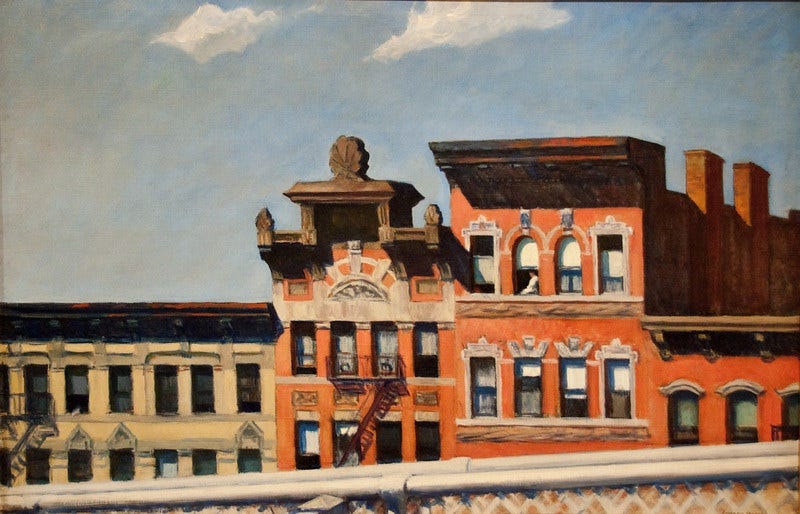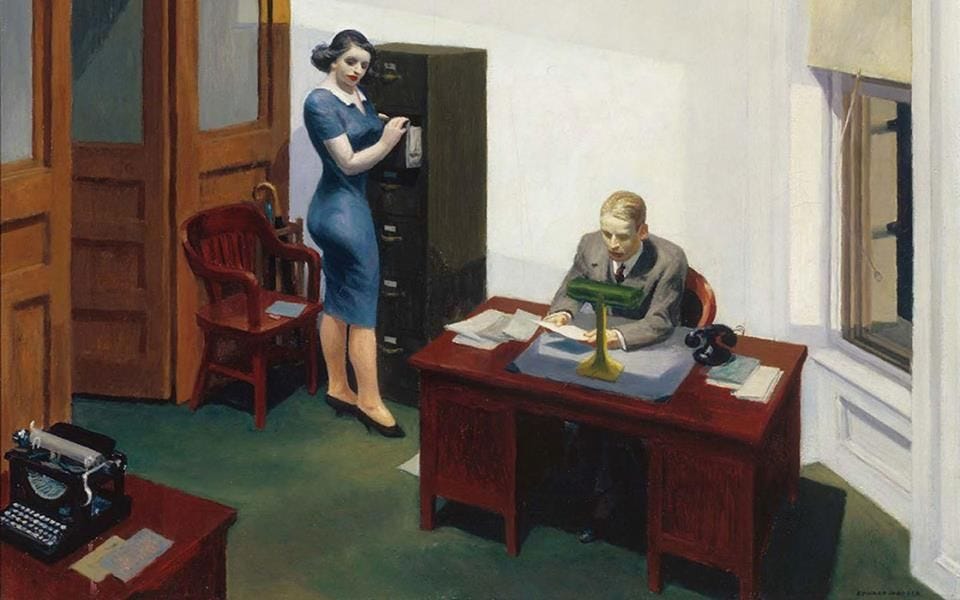Edward Hopper’s New York
The Whitney Museum exhibition of Edward Hopper’s New York paintings reveals a painter who absorbed, distilled, and represented the sensory experience of everyday life lived in a particular infrastructure, a particular moment in the ongoing urbanization of the place we call New York City. Hopper reached adulthood at the moment of consolidation, when New York’s five boroughs, once separate cities, coalesced into a political-geographical unit of overwhelming size. Growth was both extensive and intensive, as consolidation was followed by what the historian Mike Wallace calls “a qualitative transformation in the city’s scale, dynamics, composition, and appearance.”1 The new infrastructure—bridges, subways, skyscrapers, electricity—both accommodated and fostered new ways of life, depicted by Hopper in his images of forlorn offices and women drinking coffee by themselves at night. Read as whole, Hopper’s New York paintings depict the twentieth century pressing in on the nineteenth until the remnants of the latter become lifeless shells, unmoored from the vanished society that created them.
In the city, interior and exterior are hopelessly scrambled. Hopper liked to paint scenes glimpsed through windows, often from the perspective of Manhattan’s elevated rail lines, most of which were dismantled by the end of the Second World War. The apartments, offices, and cafés Hopper painted are stark and heavy, their blank walls bathed in a cold, electric light (the exhibition reveals that Hopper had once done commercial drawings for Con Edison). Sunlight is always modulated by brick, glass, and concrete. Human beings, when they appear, stare impassively—but hardly ever at one another. Everyone is alone. Most of Hopper’s faces, when he bothered to detail them at all, look roughly the same. It seems clear he was interested in the types produced by the city that then represented capitalist urbanization in extremis. These are spaces that felt like they could be erased in a day—and then were.
After looking at Hopper’s paintings, I walked around the corner to Hector’s Cafe and Diner, a holdover from the days when these blocks teemed with slaughterhouses and BDSM clubs. When I met the man behind the cash register to pay my check, I asked him how long the place had been around. He gave me a look of great agita. “Since the Mohicans,” he groaned. And then clarified: “1949.”
Three Recent Pieces
Three relatively recent pieces in various locales:
For the Brooklyn Rail, I wrote about Eric Adams, the return of the plainclothes anti-crime units (excuse me, “Neighborhood Safety Teams”), and the class politics of torturing the unhoused.
For International Labor and Working-Class History, I wrote about the garment industry and the deindustrialization of New York City. (If you can’t access the article, get in touch and I can send it.)
For Spectre, I wrote (in two parts) about the broad history of New York City in terms of temporality; abstraction; the built environment; Joseph Mitchell; Robert Moses; the cold, smooth rationalization of a once unruly city; Henri Lefebvre's "right to the city"; and the notion of a Gothic city, which consists in using the existing city "wrongly" ...
On the Playlist
I’ve been posting a bunch of “songs of the day” on Twitter and Instagram, although the relative implosion of the former, surely the most noxious of the platforms, has given me an excuse to stop using it. A lot of the songs come from this mix, inspired by an exhibit of Bill Bernstein’s 1970s NYC dance scene photos. This is the type of music you might have heard at Better Days or the Paradise Garage, which seem like Eden in their disregard of arbitrary genre boundaries and symbiotic connection to social liberation.
Check out “Handsome Man”:
The best places to learn about the politics, economy, and society of New York dance music culture in the 70s and 80s are Tim Lawrence’s two books, Love Saves the Day: A History of American Dance Music Culture, 1970-1979 and Life and Death on the New York Dance Floor, 1980–1983, as well as the podcast he hosts along with his friend Jeremy Gilbert. And Nicky Siano, who at age seventeen opened The Gallery in a former manufacturing loft on 22nd Street (rent: $360 a month), is releasing his self-published memoir, chapter by chapter, on Patreon.
Mike Wallace, Greater Gotham: A History of New York City from 1898 to 1919 (New York: Oxford University Press, 2017), 7.





